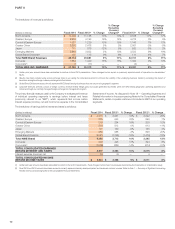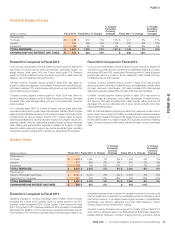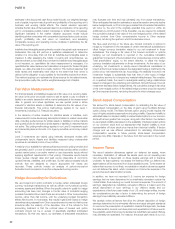Nike 2014 Annual Report Download - page 32
Download and view the complete annual report
Please find page 32 of the 2014 Nike annual report below. You can navigate through the pages in the report by either clicking on the pages listed below, or by using the keyword search tool below to find specific information within the annual report.
PART II
Fiscal 2014 Compared to Fiscal 2013
Excluding changes in currency exchange rates, fiscal 2014 revenues for
Emerging Markets increased 13% as a result of growth across nearly every
territory. Our largest territory, Brazil, grew 19%, while our SOCO territory
(which includes Argentina, Uruguay, and Chile) grew 25%. Mexico revenues
decreased 3% as a result of shipping delays caused by issues with a
distribution center transition in the first half of fiscal 2014. On a category basis,
revenues were higher in nearly every category, led by Football (Soccer),
Running, and Sportswear.
Constant currency footwear revenue growth for fiscal 2014 was driven by
growth in nearly every key category, led by Running, Sportswear, Football
(Soccer), and Action Sports. Unit sales for fiscal 2014 increased 4% and
average selling price per pair increased 6%, primarily driven by price
increases, in part reflecting inflationary conditions in certain Latin American
territories, and to a lesser extent, a shift in mix to higher priced product.
Constant currency apparel revenues increased driven by growth in every key
category, most notably Football (Soccer) and Running. Unit sales increased
11% and average selling price per unit increased 10%, primarily due to price
increases, in part reflecting inflationary conditions in certain Latin American
territories.
Fiscal 2014 reported EBIT for Emerging Markets decreased primarily due to a
decline in gross margin, higher selling and administrative expense, and
weaker currencies in a number of developing markets. Gross margin
decreased 30 basis points due primarily to unfavorable foreign currency
exchange rates, higher product costs, higher warehousing costs related to
distribution center transition challenges in Mexico, and higher discounts,
which more than offset higher average selling prices and a favorable shift to
higher priced products. Selling and administrative expense increased due to
higher operating overhead costs to support the expansion of our DTC
business and infrastructure investments to support growth, as well as
increases in demand creation spending to support the World Cup and key
product launches.
Fiscal 2013 Compared to Fiscal 2012
For fiscal 2013, constant currency revenue growth for the Emerging Markets
geography was driven by growth in every key category and territory, led by
SOCO, Brazil, and Mexico.
Constant currency footwear revenue growth for fiscal 2013 was driven by
growth in most key categories, most notably Running, Football (Soccer), and
Women’s Training. Unit sales increased approximately 9% and average
selling price per pair increased 6%, primarily driven by selling price increases.
Fiscal 2013 constant currency apparel revenues were driven by growth in
every key category, led by Football (Soccer), Running, Sportswear, and
Men’s Training. Unit sales increased approximately 10% and average selling
price per unit increased 9%, largely attributable to price increases.
Fiscal 2013 Emerging Markets EBIT grew faster than revenue primarily driven
by gross margin improvement, partially offset by higher selling and
administrative expense as a percent of revenue. Gross margin increased 260
basis points due largely to the favorable impact of price increases, the
anniversary of a one-time customs duty charge in fiscal 2012, and favorable
standard foreign currency exchange rates, which more than offset the
unfavorable impact of higher product costs. As a percent of revenue, selling
and administrative expense was higher due to higher operating overhead
costs to support the expansion of our DTC business and overall growth of the
business.
Global Brand Divisions
(Dollars in millions) Fiscal 2014 Fiscal 2013 % Change
% Change
Excluding
Currency
Changes Fiscal 2012 % Change
% Change
Excluding
Currency
Changes
Revenues $ 125 $ 115 9% 6% $ 111 4% 7%
(Loss) Before Interest and Taxes $ (2,021) $ (1,746) 16% $ (1,479) 18%
Global Brand Divisions primarily represent demand creation, operating
overhead, and product creation and design expenses that are centrally
managed for the NIKE Brand. Revenues for Global Brand Divisions are
primarily attributable to NIKE Brand licensing businesses that are not part of a
geographic operating segment.
Fiscal 2014 Compared to Fiscal 2013
For fiscal 2014, Global Brand Divisions’ loss before interest and taxes
increased $275 million, primarily driven by an increase in centrally managed
product costs, increased investments in our digital infrastructure, higher
demand creation spending in the fourth quarter of fiscal 2014 to support the
World Cup, and product creation and design initiatives.
Fiscal 2013 Compared to Fiscal 2012
For fiscal 2013, Global Brand Divisions’ loss before interest and taxes
increased $267 million, primarily driven by increased investments and
marketing support for our digital business, product creation and design
initiatives, and higher demand creation spending in the first quarter of fiscal
2013 around the Olympics and European Football Championships.
Converse
(Dollars in millions) Fiscal 2014 Fiscal 2013 % Change
% Change
Excluding
Currency
Changes Fiscal 2012 % Change
% Change
Excluding
Currency
Changes
Revenues $ 1,684 $ 1,449 16% 15% $ 1,324 9% 10%
Earnings Before Interest and Taxes $ 496 $ 425 17% $ 394 8%
In territories we define as “direct distribution markets,” Converse designs,
markets, and sells products directly to distributors, wholesale customers, and
to consumers through DTC operations. The largest direct distribution markets
are the United States, the United Kingdom, and China. Converse does not
own the Converse trademarks in Japan. Territories other than direct
distribution markets and Japan are serviced by third-party licensees who pay
royalty revenues to Converse for the use of its registered trademarks and
other intellectual property rights.
NIKE, INC. 2014 Annual Report and Notice of Annual Meeting 75
FORM 10-K
























